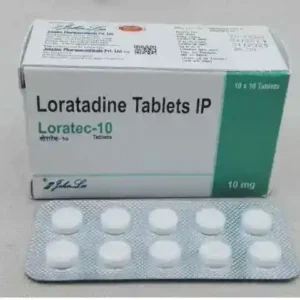Loratadine is an antihistamine used to alleviate allergy symptoms such as sneezing, runny nose, itching, and watery eyes due to hay fever or other upper respiratory allergies. It’s sold under various brand names, with Claritin being one of the most well-known.
Key points about loratadine:
Antihistamine
Like other antihistamines, loratadine works by blocking histamine, a substance released by the body during an allergic reaction. By inhibiting histamine’s action, it helps relieve allergy symptoms.
Non-Drowsy Formula
Similar to fexofenadine (Allegra), loratadine is known for its non-drowsy or less sedating effects compared to older generation antihistamines. It’s often preferred for daytime use because it typically doesn’t cause as much drowsiness.
Symptom Relief
Loratadine can effectively alleviate symptoms like sneezing, itching, runny nose, and watery eyes caused by allergies. However, it might not be as effective for symptoms like congestion.
Dosage and Usage
The typical dosage for adults and children over 6 years old is 10 mg once daily. It’s available in various formulations, including tablets, chewable tablets, and syrup. Dosages might vary for younger children.
Precautions and Side Effects
While loratadine is considered safe for most people, it’s essential to be aware of potential side effects such as headache, dry mouth, and fatigue. It’s also important to consult a healthcare professional before using loratadine if you have certain medical conditions or are taking other medications to avoid interactions.
Availability
In many countries, loratadine is available over-the-counter without a prescription.
Mechanism of Action
It is a second-generation antihistamine that works by selectively blocking histamine H1 receptors. Histamine is a substance released by the body during an allergic reaction, causing symptoms such as itching, sneezing, runny nose, and watery eyes. By blocking these receptors, Loratadine helps alleviate these symptoms.
Onset and Duration of Action
After ingestion, Loratadine typically starts working within 1 to 3 hours, providing relief from allergy symptoms. Its effects can last for up to 24 hours, making it suitable for once-daily dosing.
Compatibility and Precautions
It is generally well-tolerated, but it’s essential to be cautious when using it with certain medications or in specific health conditions. Always consult a healthcare professional if you’re taking other medications, especially those that might interact with Loratadine. Additionally, individuals with liver problems might need adjustments in dosage or frequency.
Age Recommendations
Loratadine is approved for use in children over a certain age, usually 6 months or older, depending on the formulation. Dosages might vary for children based on their weight or age. Always follow pediatric dosing guidelines provided by healthcare professionals.
Side Effects
While Loratadine is generally considered safe, some individuals may experience side effects such as headache, drowsiness (though less common than with older antihistamines), dry mouth, and fatigue. Serious side effects are rare but might include allergic reactions or severe dizziness.
Special Considerations
Pregnant or breastfeeding individuals should consult a healthcare professional before using Loratadine to ensure its safety during pregnancy or while nursing.
Remember, while Loratadine is available over-the-counter in many places, it’s crucial to use it as directed and seek medical advice if you have any concerns or questions about its usage or potential interactions with other medications.




Reviews
There are no reviews yet.